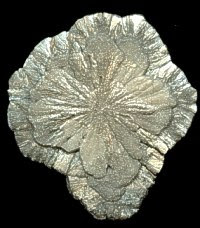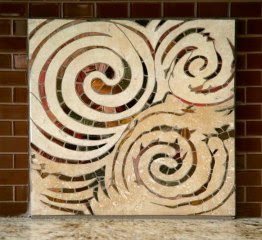Yesterday I started struggling with the color for Luke's background. There's not a lot of background space to work with, so I was thinking that a solid color would work best and not distract from Luke himself. I picked out a few colors of marble and mosaic-gold and placed pieces on the mosaic to see what the color would look like and then photographed each.

You can see larger versions of these photos here.
I next engaged all of my alter egos in a heated debate - this one too bright; that one too dull; he looks jaundiced; he looks sickly; too gaudy; so on and so on. I quickly got tired of that game. Besides, it's no fun arguing with yourself.
So I got out my phone book, looked up Mosaic Gurus in the yellow pages, and sent them the photos of my dilemma. I told them that I wasn't concerned about making him look saintly and that I didn't necessarily have to follow the tradition of putting a halo around him. Saint or not, he's an interesting dude.
Not surprising, each guru came back with a different answer. Their wisdom is a real gift and has given me a lot to think about.
Here's a summary of their remarks:
Did you not consider using a very dark tone? That's what I see. Sad guy, sitting in the dark. I see you might be concerned about the hair contrast, but I think you could get around it.
In short, my answers for 1st choice etc, are:
In 1st place- Gold
2nd place-Gold
Distant third –silverwater
Even if Luke is just a dude, you’ve spent all that time being accurate about his person, so I think to finish him off in style you should really spring for the gold, which is in the original. It looks like you’ve got bumpy gold there, which looks fabulous, and would be my choice too.
I'm voting Royal Gold or Pistachio.
Royal gold because I think the yellow in that will play into the yellows in the face -- kind of a color link between object and background -- and give the "hint of a halo".
Pistachio because I just like the looks of it.
Pistachio definitely. That will let the face be the focus.
Silverwater: too dull?
royal yellow: I'm likin' it- warm, enough contrast to hair and allows figure to pop.
pistachio - perhaps better as an ice cream treat once background is finished.
mugwort green - hand cut better than square cut tiles, but if that is not issue, color is a bit too light?
green jade - seems this color doesn't relate that well to other marble used.
copper gold - stunning, love it.
blue - not! But good on ya for throwing that into the mix.
gold - too predictable? does lend religious overtone for "Just a Dude"
I vote strongly for silverwater. It is the most muted, and subtle. Second choice would be royal yellow, because it's neutral but rich in color and, like XX says, plays with the same colors in the face.
The reason I like silverwater is that it isn't trying too hard to be matchy, and it allows Luke's face to take precedence over the background. Makes him look as if he appeared in a natural environment. I also will advocate speckling or feathering in from a lighter to a darker color (either direction). And...and, am I getting really bossy and opinionated here? You vill of course make zem zeh same general size as zeh rest of zeh werk, ya. You vill.
My 15 yr old votes for the copper gold. She says that the others blend in too much and the contrast is nice with the copper gold. I agree a bit with her, but also like the pistachio.
I would love to see a blend of the top three colors (royal yellow, pistachio, silverwater) in which you step outwards from brightest (yellow) to darkest (silverwater). This would give it a subtle halo effect.
I vote for Royal Yellow. I think silverwater is too cool...at least on my screen. It seems to pull it down.
I have lots to say, so don’t start rolling your eyes—yet.
I love how you finished out your Luke. He looks great. But don’t kid yourself! I’m not religious either (even though my daddy was a Methodist preacher!!), but there is no getting away from the saintly, long-suffering look he has about him.
Color Choices
That being said- here goes the color theory lesson. The green colors- Pistachio, Mugwart and Jade bring out the green in his face, so they make him look a little sickly—like he needs to vomit—Yikes!
Silverwater, again, brings out the grey tones- so it looks like he’s been dead a long time, yet is resurrected (how biblical).
Blue Gold is just simply too fabulous. You will lose all of your more subtle color choices, and it has a very modern feel to it. Cobalt-y colors were not used much in ancient art because there was no easy way to process the ore. Even today anything this color (like oil paint) is more expensive because of the process of making it. So blue is just not a believable background for your ancient- or Byzantine-styled face. (Unless he’s in Ravenna with the stars).
Okay, Marble-Man, get rid of that [
censored] bumpity gold! Throw it out!!! I can’t stand it!!!! (Sorry, got carried away!) The only gold you should use, IF you wanted everyone to know that this dude is a religious figure, is a very dark yellow, antiqued or “crackled” surface. I could send you a free sample of one that I have that could work.
So, that leaves us with your yellow tones. I like your Royal Yellow, but I wish it were a little deeper, not so white-ish. Could you try a color-enhancing liquid on it?
The tone and color of your Copper Gold is wonderful, but I fear it is metallic and we just can’t see that in the photo. Again, a metallic may look very modern, but it is the best color choice, and as long as it is not too pristine I think it could look great. The coppery tone on the Mosaic Smalti board, if this is the one, is very good. Not too shiny/glossy a surface.
Andamento (I know you didn’t ask, but I’m tellin’ ya anyway!)
I very much like the varied sizes and shapes (squares, rectangles, triangles) you’ve got going on in the Copper Gold photo. A non-andamento andamento. Because of the severity of the andamento within the central figure, it would either work well to continue in exactly the same technique, or to do something very different like this “scattered/shattered” look.
The photos where you have the background of perfected cubes of marble lined up—they are not very attractive. The scale is not right, and neither is the uniformity and rigidity of the style for your lovely work. The background would over-power it.
I am voting GOLD.....
I'm looking forward to checking out the decision process on the blog. Backgrounds are always the hardest part for me. I focus so much on composition, and know that in a clinch, the wrong decision can change the entire tone of the piece (no pressure, by the way).
Ah, the background question, a bit hard to tell in pics, but I am curious, what is the color of the line in his collar? You used a thicker, almost light purplish stone there. I am wondering how that would look, it has me curious. I do not think you have that color anywhere else in his face do you?
I also like the Royal Yellow, Pistachio. I love the golds too, but they are a bigger contrast, I am afraid the gold may over power all your hard work and he might fade into the background.
* * *
Well, there you have it. This is such a great wealth of ideas and I thank the gurus for sharing this with me.
I do have my own opinion which is coming more from a gut feeling than from a rational choice. Sometimes it's good to listed to one's gut. Then again, I've observed that the quality that separates good artists from great ones is "intention" - Great artists do things for a reason. It might not be an overly rationalize, thought-out reason, but there is intention behind everything they do.
I'm mulling over the situation.
 River's Edge by Sherman Hay
River's Edge by Sherman Hay































 Connie
Connie















